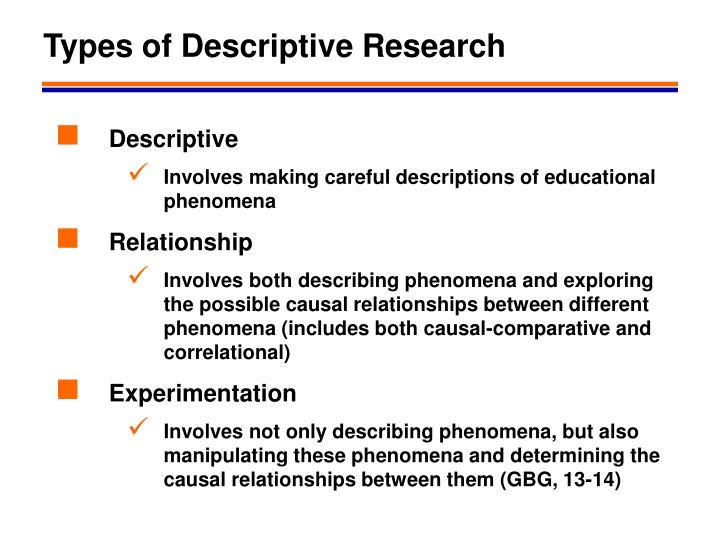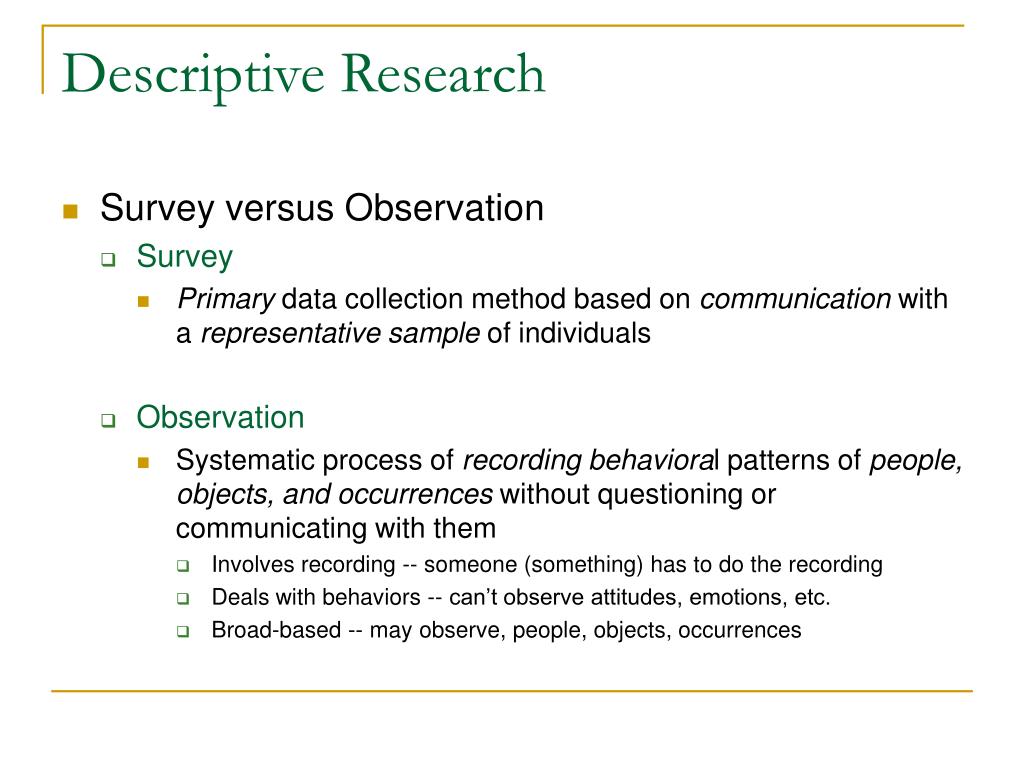Table Of Content

The case study could involve interviews with the owners of the business, observation of their business practices, and analysis of their financial data to document the costs and benefits of sustainability initiatives. In this stage, you will have to identify which tools and techniques are relevant and valid to your study. Leverage robust survey software that offers you multiple channels, thus enabling you to utilize various channels to gather insights. Results obtained through the descriptive method of research often have high external validity as research is conducted in the respondent’s natural environment and no variables are manipulated. Descriptive research often uses quantitative and qualitative research in amalgamation, providing a more holistic understanding of the research topic. The descriptive method of research can be used to measure changes in variables over a period of time, allowing trends to be identified and analyzed.
Sources of Data
The goal of descriptive research is to provide a comprehensive and accurate picture of the population or phenomenon being studied and to describe the relationships, patterns, and trends that exist within the data. If these data are analyzed only to determine the distribution of one or more variables, these are “descriptive.” However, often, in a cross-sectional study, the investigator also assesses the relationship between the presence of an exposure and that of an outcome. Such cross-sectional studies are referred to as “analytical” and will be discussed in the next article in this series. One of the first steps in planning a research study is the choice of study design. The available study designs are divided broadly into two types – observational and interventional. Of the various observational study designs, the descriptive design is the simplest.
Characteristics of descriptive research
A descriptive research design can use a wide variety of research methods to investigate one or more variables. Unlike in experimental research, the researcher does not control or manipulate any of the variables, but only observes and measures them. Descriptive research provides a comprehensive picture of the characteristics and behaviors of a particular population or phenomenon, allowing researchers to gain a deeper understanding of the topic.
Participants and Sampling

When researchers use observational methods, respondents may also decide to behave in a particular manner because they feel they are being watched. As we’ve mentioned, descriptive research design is ideal for understanding the what, who or where of a situation or phenomenon. Plus, the data collected from descriptive research can be subjected to other types of data analysis. This method involves comparing data across different groups or time periods to identify similarities and differences. Comparative analysis can help describe changes in attitudes or behaviors over time or differences between subgroups within a population. As one of our key informant interviewees [District Disease Prevention Head], described health professionals’ low engagement has been due to fear of perceived susceptibility.
The researchers can then use the findings of the case study to provide a detailed account of the business’s approach to sustainability and to identify best practices that could be applied to other businesses. The target population is the group of individuals that you are examining in your research study. Additionally, unless you are conducting a census study and collecting data from the entire population, you must select a sample group.
Cross-sectional study for derivation of a cut-off value for identification of an early versus delayed diagnosis of ... - BioMed Central
Cross-sectional study for derivation of a cut-off value for identification of an early versus delayed diagnosis of ....
Posted: Wed, 14 Dec 2022 08:00:00 GMT [source]
The insights gained from a descriptive research can inform future research and inform policy decisions and programs. Descriptive research can provide valuable information and insights into a particular topic, which can inform future research, policy decisions, and programs. The absence of statistical and in-depth analysis and the rather superficial character of the investigative procedure are drawbacks of this research approach.
(PDF) A Descriptive study to assess the knowledge and attitude regarding basic life support among non-medical ... - ResearchGate
(PDF) A Descriptive study to assess the knowledge and attitude regarding basic life support among non-medical ....
Posted: Fri, 01 Sep 2023 07:00:00 GMT [source]
Comparison points, assumption of similarities, and criteria of comparison are three important variables that affect how well and accurately comparative studies are conducted. Your survey might be a brief interview or conversation with a set of prepared questions intended to obtain quick information from the primary source. Descriptive research differs from experimental research in that researchers cannot manipulate the variables.

Descriptive research aims to describe and document the characteristics, behaviors, or phenomena of a particular population or situation. It focuses on providing an accurate and detailed account of the existing state of affairs. A case study is a sample group (an individual, a group of people, organizations, events, etc.) whose characteristics are used to describe the characteristics of a larger group in which the case study is a subgroup.
In our study, healthcare provider’s capability (competence) also had an impact on their ability to engage in prevention and management of MDR-TB. Here, participants had frequently raised their and other healthcare providers’ experience regarding skill gaps, negative attitude towards the service unit they were working in, ineffective use of MDR-TB guideline, poor infection prevention practices and commitment. In addition, many health professionals report serious problems regarding case identification and screening, drug administration, and side effect management. These findings were supported by other studies in Ethiopia [7] and in Nigeria [19, 20]. This implies an urgent need for training of health care worker on how to engage in prevention and management of multidrug resistant TB. Focus group discussion and face to face key informants’ interviews were employed to collect the data.
Thus, descriptive research is often used to generate hypotheses that should be tested using more rigorous designs. An exploratory design is conducted about a research problem when there are few or no earlier studies to refer to or rely upon to predict an outcome. The focus is on gaining insights and familiarity for later investigation or undertaken when research problems are in a preliminary stage of investigation. Exploratory designs are often used to establish an understanding of how best to proceed in studying an issue or what methodology would effectively apply to gathering information about the issue.
Descriptive research is a methodological approach that seeks to depict the characteristics of a phenomenon or subject under investigation. In scientific inquiry, it serves as a foundational tool for researchers aiming to observe, record, and analyze the intricate details of a particular topic. This method provides a rich and detailed account that aids in understanding, categorizing, and interpreting the subject matter.
Additionally, Li et al. (2014) specifically reported use of a grounded-theoryapproach. Qualitative description (QD) is a label used in qualitative research for studieswhich are descriptive in nature, particularly for examining health care and nursing-relatedphenomena (Polit & Beck, 2009, 2014). QD is a widely cited research tradition and has beenidentified as important and appropriate for research questions focused on discovering the who,what, and where of events or experiences and gaining insights from informants regarding apoorly understood phenomenon. It is also the label of choice when a straight description of aphenomenon is desired or information is sought to develop and refine questionnaires orinterventions (Neergaard et al., 2009; Sullivan-Bolyai et al., 2005).
Surveys help create better policies and cross-sectional studies help us understand problems affecting different populations including diseases. Used in the right context, descriptive research can advance knowledge and inform decision making¹. Each of the methods used to collect descriptive data have their own strengths and limitations. The following are some of the strengths and limitations of descriptive research studies in general. Causality studies may be thought of as understanding a phenomenon in terms of conditional statements in the form, “If X, then Y.” This type of research is used to measure what impact a specific change will have on existing norms and assumptions. Causal effect (nomothetic perspective) occurs when variation in one phenomenon, an independent variable, leads to or results, on average, in variation in another phenomenon, the dependent variable.


No comments:
Post a Comment